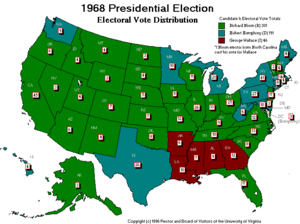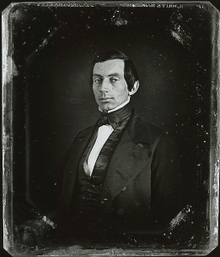
When a Political Thesis has run its course, a Transformation Election is the natural result. (Image of the 1968 electoral vote is from the University of Virginia.)
Transformation Elections are very rare. Most Americans are too young to remember the last such election campaign, in 1968. Some are old enough to remember the previous such campaign, in 1932. No one is left with real memory of the transformation which came before that.
The most important point about a Transformation Election, as opposed to the Transactional Elections normally held, is that it’s not close. A new consensus emerges, a solid majority on one side of a whole set of assumptions, some of them born in power as part of a previous AntiThesis regime, others brand new, born of movements which have never before achieved power.
Children may be taught that the 1968 contest was very close, but in truth it wasn’t. When you add George Wallace’s totals to that of Richard Nixon, 58% of voters rejected the old FDR Thesis. Nixon’s "Southern Strategy" consolidated the Wallace vote and won the 61% margin we now assume to be the natural political balance four years later.
Since 1972 Democrats have only won in extreme circumstances — Carter because of Ford’s pardon, Clinton because of Perot’s insurgency — and never with a solid majority. (Even in 1996 Clinton got just 49% of the vote against Bob Dole, a very weak Republican nominee.)
I offer this review because it’s vital you understand what is taking place, so you won’t be gulled by the TV Talking Heads into seeing this as a "horserace." That’s how Transactional Elections run, and that’s how TV likes to play all elections.
Along with a political Transformation, elections like the one we’re entering into also transform our dominant media. The 1968 campaign was played out on television, which became dominant for the first time in that cycle. The 1932 campaign was played out on radio and in movies, which became the dominant media of that time. The 1896 campaign was played out on mass market newspapers, the Yellow Press that came to dominate the succeeding era. The 1860 campaign was played out through mass market books like Uncle Tom’s Cabin, and so on.
The campaign we’ve now entered into will be played out on the Internet, on the medium you are using right now. And the Thesis which will emerge from the campaign will be based on the values of this medium — consensus, connectivity, and transparency.
Right now Democrats have two primary choices to lead them into this new era.
- Hillary Clinton is a product of the old AntiThesis. Her husband
created the Third Way that became our AntiThesis to the Reagan Era
we’re now leaving. In this she is much like Richard Nixon, who won in
1968. - Barack Obama represents a clean break with the past. He is the same
age that Bill Clinton was in 1991, when he first ran. He has no ties to
the previous AntiThesis.
Out of these two, I’m with Obama,
although if Democrats feel they need a Nixon, if they feel they can
only give this transformation rhetoric (for now), I won’t be terribly
surprised. History says Clinton is the most likely winner:
- Franklin Roosevelt, who won the 1932 election, had come out of the previous, Wilsonian AntiThesis, having run for Vice President in 1920.
- Abraham Lincoln was a minor figure in the Henry Clay
AntiThesis to the Jackson Thesis, and on the spectrum of choices
offered Republicans in 1860 he was the most moderate. - Theodore Roosevelt, who came to define the Progressive
Thesis, actually came to power through the assassination of William
McKinley, who won the power TR would wield so effectively.
Later, I’ll tell you exactly how Obama can beat Clinton. But for now
the message is simpler.
Nothing less than transformation will do.










